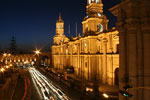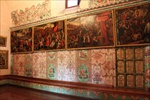Arequipa World Heritage Site
Brief Description
The historic centre of Arequipa, built in volcanic sillar rock, represents an integration of European and native building techniques and characteristics, expressed in the admirable work of colonial masters and Criollo and Indian masons. This combination of influences is illustrated by the city's robust walls, archways and vaults, courtyards and open spaces, and the intricate Baroque decoration of its facades.
Justification for Inscription
Criterion i The ornamented architecture in the historic centre of Arequipa represents a masterpiece of the creative integration of European and native characteristics, crucial for the cultural expression of the entire region. Criterion iv The historic centre of Arequipa is an outstanding example of a colonial settlement, challenged by the natural conditions, the indigenous influences, the process of conquest and evangelization, as well as the spectacular nature of its setting.
Long Description
The Historical Centre of Arequipa is an outstanding example of a colonial settlement, challenged by natural conditions, indigenous influences, the process of conquest and evangelization, and the spectacular nature of its setting. Its ornamented architecture represents a masterpiece of the creative integration of European and native characteristics, crucial for the cultural expression of the entire region.
Arequipa was founded in 1540 by a handful of conquistadores. The site was in a valley that had been intensively farmed by pre-Hispanic communities, a fact that has contributed to the topography of the place. The layout of an indigenous hamlet has survived close to the Historic Centre in the district of San Lázaro. The World Heritage site consists of 49 original blocks of the Spanish layout (excluding three blocks adjacent to the Mercado San Camilo not considered to be adequate because of their style). In addition there are 24 blocks from the colonial period and the 19th century.
Major earthquakes have marked the key moments of change in the development of Arequipa architecture. It is thus possible to identify five periods of development: foundation as a village (1540-82), Baroque splendour (1582-1784), introduction of Rococo and neoclassicism (1784-1868), modern empiricism and neoclassical fashion (1868-1960), and contemporary design. The natural disaster of 1582 caused a major change in favour of antiseismic construction, introducing a systematic use of sillar, a pink or pearl-coloured volcanic stone that was freely available. Earlier this material had only been used in the doorways of the main church and in a handful of dwellings. Being soft, light, thermic and resistant, it now provided a solution to the problems caused by earth tremors, as well as being pleasing aesthetically.
The core of the historic town is the Plaza de Armas (Plaza Mayor) with its archways, the municipality, and the cathedral, the most important neoclassical religious building in the country, constructed in the mid-19th century on the ruins of an earlier Baroque church. At one corner of the plaza there are the church and cloisters of La Compañia, the most representative ensemble of the Baroque mestizo period at the end of the 18th century. The Monasterio de Santa Catalina de Siena is a spectacular religious citadel, integrating architectural styles from the 16th to 19th centuries and having an area of 20,000 m2 . The complex of San Francisco includes a small square, the main church, the convent, and the cloisters of the third order.
The chapels and convents of Santo Domingo date from the 16th to 18th centuries: San Agustín, La Merced and the church of Santa Maria; Santa Teresa and Santa Rosa; Puente Real (now Puente Bolognesi) and Puente Grau are also built from sillar. The Historic Centre contains some 500 casonas , of which over 250 are listed for protection. These were generally built in the 19th century on the sites of earlier colonial buildings destroyed in the 1868 earthquake. The heavy structures have been enhanced with ornamental designs in large thick rounded frames or deep protrusions and sculptures on flat surfaces. Light combines with such features to create a dynamism which alleviates the heaviness of the structure and makes it more interesting. The lateral doorway of the Iglesia de Santo Domingo, an allegory of the Last Judgement, is an example of such artistic expressions, typically found in all doorways of the city and the region.
The merit of Arequipa architecture is not limited to the grandeur of its religious monuments. It is also in the profusion of dignified casonas, characteristic well-proportioned vernacular houses. The urban space penetrates the interior of the city blocks through large doorways and hallways into the courtyards, where the carvings of the facades are reproduced, thus accentuating spatial continuity. Doorways and windows are flanked with pillars and crowned with protruding pediments that blend with the large walls. The ornamental economy of the porches harmonizes with the shape of the vaults, the projecting cornices and the carved corbels. Narrow window openings allow light to enter the semi-circular arches or vaulted roof spaces. Together with the monumental ensembles, streets, and squares the casonas ensure the harmony and integrity of the townscape and give the city exceptional urban value.
Source: UNESCO/CLT/WHC
Historical Description
Arequipa was founded on 15 August 1540 by a handful of Spanish conquistadores. The site was in a valley that had been intensively farmed by pre-Hispanic communities, a fact that has contributed to the topography of the place. The layout of an indigenous hamlet has survived close to the Historic Centre in the district of San Lázaro.
Major earthquakes have marked the key moments of change in the development of Arequipa architecture. It is thus possible to identify five periods of development: the foundation period as a village (1540-82), the period of Baroque splendour (1582-1784), the introduction of Rococo and Neo-Classicism (1784-1868), modern empiricism and Neo-Classical fashion (1868-1960), and contemporary design. The city underwent its principal development in the era of the viceroyalty and it was an important economic centre in the southern Andes. Its role in the history of the Peruvian Republic was, and continues to be, crucial. The Historic Centre has been a centre of popular civic rebellions and demonstrations, as well as being the birthplace of many outstanding intellectual, political, and religious figures in the country.
The first buildings in Arequipa were constructed using adobe and stone, with roofs of straw, sticks, or mud. Some of these still exist in the old district of San Lázaro. Later building materials were brick and straw, still found in some examples in the Convent of Santa Catalina. The natural disaster of 1582 caused a major change in favour of antiseismic construction, introducing a systematic use of sillar, a pink or pearl-coloured volcanic stone that was freely available. Earlier this material had only been used in the doorways of the main church and in a handful of dwellings. Being soft, light, thermic, and resistant, it now provided a solution to the problems caused by earth tremors, as well as being pleasing aesthetically.
Source: Advisory Body Evaluation
Arequipa City Location
- Peru
- Province of Arequipa
- S16 23 60 W71 31 60
- Date of Inscription: 2000
- Criteria: (i)(iv)
- Property : 167 ha
- Buffer zone: 165 ha
- Ref: 1016
 AREQUIPA PHOTO GALLERY...
AREQUIPA PHOTO GALLERY...
- Casa del Moral
- Children of Colca
- Colca Canyon Landscapes
- Colca Valley Landscapes
- Colca Valley Landscapes 2
- Colonial Large Houses
- La Catedral (The Cathedral)
- La Compañía - Church
- La Compañía - Cloister
- La Mansión del Fundador








